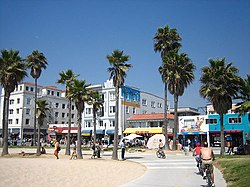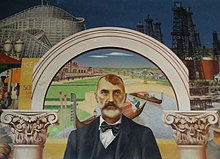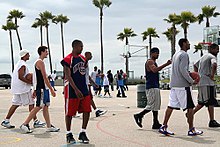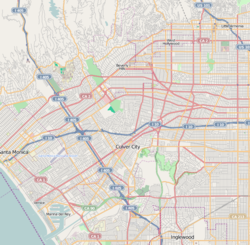
A | B | C | D | E | F | G | H | CH | I | J | K | L | M | N | O | P | Q | R | S | T | U | V | W | X | Y | Z | 0 | 1 | 2 | 3 | 4 | 5 | 6 | 7 | 8 | 9
Venice | |
|---|---|
 Venice Beach and Boardwalk, 2005 | |
 Venice boundaries | |
| Coordinates: 33°59′27″N 118°27′33″W / 33.99083°N 118.45917°W | |
| Country | |
| State | |
| County | Los Angeles |
| City | Los Angeles |
| Founded as an independent city | 1905 |
| Merged with Los Angeles | 1926 |
| Named for | Venice, Italy |
| Government | |
| • City Council | Traci Park (D) |
| • State Senate | Ben Allen (D) |
| • State Assembly | Autumn Burke (D) |
| • U.S. House | Ted Lieu (D) |
| Area | |
| • Total | 3.1 sq mi (8 km2) |
| Elevation | 10 ft (3 m) |
| Population (2008)[1] | |
| • Total | 40,885 |
| • Density | 12,324/sq mi (4,758/km2) |
| Time zone | UTC-8 (PST) |
| • Summer (DST) | UTC-7 (PDT) |
| ZIP Codes | 90291, 90292 |
| Area codes | 310, 424 |
| Website | laparks |
Venice is a neighborhood of the City of Los Angeles within the Westside region of Los Angeles County, California, United States.
Venice was founded by Abbot Kinney in 1905 as a seaside resort town. It was an independent city until 1926, when it was annexed by Los Angeles. Venice is known for its canals, a beach, and Ocean Front Walk, a 2.5-mile (4 km) pedestrian promenade that features performers, fortune-tellers, and vendors.
History
19th century
In 1839, a region called La Ballona that included the southern parts of Venice, was granted by the Mexican government to Ygnacio and Augustin Machado and Felipe and Tomas Talamantes, giving them title to Rancho La Ballona.[3][4][5] Later this became part of Port Ballona.
Founding


Venice, originally called "Venice of America", was founded by wealthy developer Abbot Kinney in 1905 as a beach resort town, 14 miles (23 km) west of Los Angeles. He and his partner Francis Ryan had bought 2 miles (3 km) of ocean-front property south of Santa Monica in 1891. They built a resort town on the north end of the property, called Ocean Park, which was soon annexed to Santa Monica. After Ryan died, Kinney and his new partners continued building south of Navy Street. After the partnership dissolved in 1904, Kinney, who had won the marshy land on the south end of the property in a coin flip with his former partners, began to build a seaside resort like the namesake Italian city.[6]: 8
When Venice of America opened on July 4, 1905, Kinney had dug several miles of canals to drain the marshes for his residential area, built a 1,200-foot-long (370 m) pier with an auditorium, ship restaurant, and dance hall, constructed a hot salt-water plunge, and built a block-long arcaded business street with Venetian architecture. Kinney hired artist Felix Peano to design the columns of the buildings.[6]: 22 Included in the capitals are several faces, modeled after Kinney and a woman named Nettie Bouck.[7][8]

Tourists, mostly arriving on the "Red Cars" of the Pacific Electric Railway from Los Angeles and Santa Monica, then rode the Venice Miniature Railway and gondolas to tour the town.[9] The biggest attraction was Venice's 1-mile-long (1.6 km) gently-sloping beach.[10] Cottages and housekeeping tents were available for rent.[11][12]
The population (3,119 residents in 1910) soon exceeded 10,000; the town drew 50,000 to 150,000 tourists on weekends.[13][citation needed]
Amusement pier



For the amusement of the public, Kinney hired aviators to do aerial stunts over the beach. One of them, movie aviator and Venice airport owner B. H. DeLay, implemented the first lighted airport in the United States on DeLay Field (previously known as Ince Field). After a marine rescue attempt was thwarted, he organized the first aerial police force in the nation. DeLay performed many of the world's first aerial stunts for motion pictures in Venice.[citation needed]
Attractions on the Kinney Pier became more amusement-oriented by 1910, when a Venice Miniature Railway, Aquarium, Virginia Reel, Whip, Racing Derby, and other rides and game booths were added. Since the business district was allotted only three one-block-long streets, and the City Hall was more than a mile away, other competing business districts developed. Unfortunately, this created a fractious political climate. Kinney, however, governed with an iron hand and kept things in check. When he died in November 1920, Venice became harder to govern. With the amusement pier burning six weeks later in December 1920, and Prohibition (which had begun the previous January), the town's tax revenue was severely affected.[citation needed]
The Kinney family rebuilt their amusement pier quickly to compete with Ocean Park's Pickering Pleasure Pier and the new Sunset Pier. When it opened it had two roller coasters, a new Racing Derby, a Noah's Ark, a Mill Chutes, and many other rides. By 1925, with the addition of a third coaster, a tall Dragon Slide, Fun House, and Flying Circus aerial ride, it was the finest amusement pier on the West Coast. Several hundred thousand tourists visited on weekends. In 1923, Charles Lick built the Lick Pier at Navy Street in Venice, adjacent to the Ocean Park Pier at Pier Avenue in Ocean Park. Another pier was planned for Venice in 1925 at Leona Street (now Washington Street).
Politics
In 1922, Venice treasurer James T. Peasgood was convicted of embezzling thousands of dollars from the city government.[14] By 1925, Venice's politics had become unmanageable because its roads, water and sewage systems badly needed repair and expansion to keep up with its growing population. When it was proposed that Venice consolidate with Los Angeles, the board of trustees voted to hold an election. Consolidation was approved at the election in November 1925, and Venice was merged with Los Angeles in 1926.[6]: 8
Many streets were paved in 1929, following a three-year court battle led by canal residents. Afterward, the Department of Recreation and Parks intended to close three amusement piers, but had to wait until the first of the tidelands leases expired in 1946.[15]
Oil
In 1929, oil was discovered south of Washington Street on the Venice Peninsula, now known as the Marina Peninsula neighborhood of Los Angeles. Within two years, 450 oil wells covered the area, and drilling waste clogged the remaining waterways. The short-lived boom provided needed income to the community, which otherwise suffered during the Great Depression. Most of the wells had been capped by the 1970s, and the last wells, near the Venice Pavilion, were capped in 1991.[16]
Neglect
After annexation, the city of Los Angeles showed little interest in maintaining the unusual neighborhood. Most of the canals were filled in and paved over, and the former lagoon became a traffic circle. The neighborhood lacked the automobile-centric, homogeneous character that the city sought to cultivate in the post-World War II era, and was perceived as a dated, obsolete remnant of earlier decades' land speculation.[17]
Los Angeles had neglected Venice so long that, by the 1950s the neglect had led to the area being labeled the "Slum by the Sea". With the exception of new police and fire stations in 1930, the city spent little on improvements after annexation. The city did not pave Trolleyway (Pacific Avenue) until 1954 when county and state funds became available. Low rents for run-down bungalows attracted predominantly European immigrants (including a substantial number of Holocaust survivors) and young counterculture artists, poets, and writers. The Beat Generation hung out at the Gas House on Ocean Front Walk and at Venice West Cafe on Dudley.[18]
Past gang activity
The Venice Shoreline Crips and the Latino Venice 13 (V-13) were the two main gangs active in Venice. V13 dates back to the 1950s, while the Shoreline Crips were founded in the early 1970s, making them one of the first Crip sets in Los Angeles.[citation needed] In the early 1990s, V-13 and the Shoreline Crips were involved in a fierce battle over crack cocaine sales territories.[19]
By 2002, the numbers of gang members in Venice were reduced due to gentrification and increased police presence. According to a Los Angeles City Beat article, by 2003, many Los Angeles Westside gang members had resettled in the city of Inglewood.[20]
Housing and homelessness
Venice Beach is one of the most difficult places in the United States to build new housing due to stringent zoning regulations.[21] Between 2007 and 2022, the number of available housing units actually decreased, despite a massive increase in property values and construction activity over the same period.[21] The neighborhood was developed early in the history of Los Angeles, and as such much of the housing stock predates the current system of zoning regulations by decades. In the areas along Pacific avenue, many early 1900's multifamily buildings still exist, some housing as many as 30 units on a single lot with no parking. Current regulations mandate lower housing densities (most commonly 1 unit per 1,500 square feet of lot area).[22]
As per a 2020 count, there were around 2,000 homeless people in Venice,[23] up from 175 in 2014. Many of them take up residence in tents and tent cities.[24] An LAPD official said that the increased homeless population has contributed to a spike in crimes in Venice in 2021.[23] In February 2020, the city opened a 154-bed transitional housing shelter at a former Metro bus yard.[25]
Geography

Venice is bounded on the northwest by the Santa Monica city line. The northern apex of the Venice neighborhood is at Walgrove Avenue and Rose Avenue, abutting the Santa Monica Airport. On the east, the boundary runs north–south on Walgrove Avenue to the neighborhood's eastern apex at Zanja Street, thus including the Penmar Golf Course but excluding Venice High School. The boundary runs on Lincoln Boulevard to Admiralty Way, excluding all of Marina del Rey, south to Ballona Creek.[26][27]
Cityscape
Venice Canal Historic District

Abbot Kinney Boulevard
Abbott Kinney Boulevard is a principal attraction, with stores, restaurants, bars and art galleries lining the street. The street was described as "a derelict strip of rundown beach cottages and empty brick industrial buildings called West Washington Boulevard,"[28] and in the late 1980s community groups and property owners pushed for renaming a portion of the street to honor Abbot Kinney.[29][30] The renaming was widely considered as a marketing strategy to commercialize the area and bring new high-end businesses to the area.[31][32]
72 Market Street Oyster Bar and Grill
72 Market Street Oyster Bar and Grill was one of several historical footnotes associated with Market Street in Venice, one of the first streets designated for commerce when the city was founded in 1905. During the depression era, Upton Sinclair had an office there when he was running for governor, and the same historic building where the restaurant was located was also the site of the first Ace/Venice Gallery in the early 1970s.[33]
Historic post office

The Venice Post Office, a red-tile-roofed 1939 New Deal building designed by Louis A. Simon[34] on Windward Circle, featured one of two remaining murals painted in 1941 by Modernist artist Edward Biberman. Developer Abbot Kinney is in the center[35] surrounded by beachgoers in old-fashioned bathing suits, men in overalls, and a wooden roller coaster representing the Venice Pier on one side with contrasting industrial oil derricks that were once ubiquitous in the area on the other side.[36] Senior curator of American Art at Los Angeles County Museum of Art (LACMA), Ilene Susan Fort, said this is one of the better New Deal post office murals both artistically and historically. Although it contains brightly colored elements with amusing details, the intrusion of the ominous oil rigs and wells was very relevant at the time.[37]
After the post office closed in 2012, movie producer Joel Silver unveiled plans to purchase it for 7.5 million and revamp the building as the new headquarters of his company, Silver Pictures.[38] The sale included the stipulation that he, or any future owner, preserve the New Deal-era murals and allow public access.[39] Restoration of the nearly pristine mural took over a year and cost about $100,000. LACMA highlighted the mural with an exhibit that displayed additional Biberman artworks, rare historical documents and Venice ephemera with the restored mural. Silver has a long-term lease on the mural that is still owned by the US Postal Service.[37] In May 2019, according to the Hollywood Reporter, Silver sold the building for 22.5 million to U.K. investor Alex Dellal and his real estate group founded by Jack Dellal.[40] Status of the planned renovation remains subject to further approvals. The mural's whereabouts are unknown,[41] putting the lessee in violation of the lease agreement's public access requirement.[citation needed]
Residences and streets
Many of Venice's houses have their principal entries from pedestrian-only streets and have house numbers on these footpaths. (Automobile access is by alleys in the rear.) The inland walk streets are made up primarily of around 620 single-family homes.[42] Like much of the rest of Los Angeles, however, Venice is known for traffic congestion. It lies 2 miles (3.2 km) away from the nearest freeway, and its unusually dense network of narrow streets was not planned for modern traffic.
Venice Beach




Venice Beach, which receives millions of visitors a year, has been labeled as "a cultural hub known for its eccentricities" as well as a "global tourist destination".[43][44] It includes the promenade that runs parallel to the beach, the Venice Beach Boardwalk, Muscle Beach, and the Venice Beach Recreation Center with handball courts, paddle tennis courts, a skate dancing plaza, and numerous beach volleyball courts. It also includes a bike trail and many businesses on Ocean Front Walk.[45]
The basketball courts in Venice are renowned across the country for their high level of streetball; numerous professional basketball players developed their games or have been recruited on these courts.[46]
Venice Beach will host skateboarding and 3x3 basketball during the 2028 Summer Olympics.[47]
Along the southern portion of the beach, at the end of Washington Boulevard, is the Venice Fishing Pier. A 1,310-foot (400 m) concrete structure, it first opened in 1964, was closed in 1983 due to El Niño storm damage, and re-opened in the mid-1990s. On December 21, 2005, the pier again suffered damage when waves from a large northern swell caused part of it to fall into the ocean.[48] The pier remained closed until May 25, 2006, when it was re-opened after an engineering study concluded that it was structurally sound.[citation needed]
The Venice Breakwater is an acclaimed local surf spot in Venice. It is located north of the Venice Pier and lifeguard headquarters and south of the Santa Monica Pier. This spot is sheltered on the north by an artificial barrier, the breakwater, consisting of an extending sand bar, piping, and large rocks at its end.[citation needed]
In late 2010, the Los Angeles County Board of Supervisors conducted a $1.6 million replacement of 30,000 cubic yards of sand at Venice Beach eroded by rainstorms in recent years. Although Venice Beach is located in the city of Los Angeles, the county is responsible for maintaining the beach under an agreement reached between the two governments in 1975.[49]
Oakwood
Oakwood lies inland from the tourist areas and is one of the few historically African-American areas in West Los Angeles.
East of Lincoln
East of Lincoln[50] is separated from Oakwood by Lincoln Boulevard. It extends east to the border with Mar Vista. Aside from the commercial strip on Lincoln (including the Venice Boys and Girls Club and the Venice United Methodist Church), the area almost entirely consists of small homes and apartments as well as Penmar Park and (bordering Santa Monica) Penmar Golf Course.
A housing project, Lincoln Place Apartment Homes, built by the Housing Authority of the City of Los Angeles, is currently undergoing a $140 million renovation to add 99 new market-rate apartment homes and to update the remaining 696 existing homes. A new pool, two-story fitness center, resident park and sustainable landscaping are being added.[51] Aimco, which acquired the property in 2003, had previously been in a legal battle to determine whether or not Lincoln Place could be demolished and rebuilt. In 2010, Aimco settled with tenants and agreed to reopen the project and return scores of evicted residents to their homes and add hundreds of units to the Venice area.[52]
Venice Walk Streets
The Venice Walk Streets are three pedestrian-only residential streets.
The streets are Marco Place, Amoroso Place and Nowita Place, located west of Lincoln Boulevard and east of Shell Avenue.
Los Angeles recognizes a larger North Venice Walk Streets Historic District.[53]
“The walk streets, narrower than regular streets, are too small for regulation street sweepers," so the streets had a designated smaller-size street sweeper.[54]
Subsections
According to the Venice Neighborhood Council,[55] the area can be subdivided further into the following districts:
- Ballona Lagoon West Bank
- Ballona Lagoon (Grand Canal) East Bank
- Silver Strand
- Marina Peninsula
- Venice Canals
- North Venice
- Oakwood-Milwood-South Venice
- Oxford Triangle
Climate

Like much of the rest of coastal southern California, Venice has a warm-summer Mediterranean climate,[56] with mild, wet winters and warm, dry summers. Temperatures are moderate all year, and the neighborhood boasts over 300 sunshine days per year.[56] As a result of seasonal lag, fall is usually warmer than spring in Venice. Because of its coastal location, morning fog is a common phenomenon in May and June, but occasionally July and August, as well. Los Angeles residents have a particular terminology for this phenomenon: the "May Gray", the "June Gloom", "No-Sky July" and "Fogust"; during these events, the fog will usually burn off by noon, but the fog may also linger all day. The all-time record high of 110 °F (43 °C) was observed on September 27, 2010, while the all-time record low is 32 °F (0 °C), recorded on January 14, 2007.[57] Venice is in USDA plant hardiness zone 10b, closely bordering on 11a.[58]
| Climate data for Venice, Los Angeles | |||||||||||||
|---|---|---|---|---|---|---|---|---|---|---|---|---|---|
| Month | Jan | Feb | Mar | Apr | May | Jun | Jul | Aug | Sep | Oct | Nov | Dec | Year |
| Record high °F (°C) | 91 (33) |
90 (32) |
94 (34) |
100 (38) |
101 (38) |
103 (39) |
107 (42) |
103 (39) |
110 (43) |
101 (38) |
97 (36) |
86 (30) |
110 (43) |
| Mean daily maximum °F (°C) | 64.6 (18.1) |
64.8 (18.2) |
65.2 (18.4) |
66.6 (19.2) |
68.2 (20.1) |
70.7 (21.5) |
74.2 (23.4) |
75.0 (23.9) |
74.4 (23.6) |
72.2 (22.3) |
68.4 (20.2) |
64.5 (18.1) |
69.1 (20.6) |
| Mean daily minimum °F (°C) | 49.1 (9.5) |
49.5 (9.7) |
51.3 (10.7) |
53.2 (11.8) |
56.6 (13.7) |
59.9 (15.5) |
62.7 (17.1) |
63.0 (17.2) |
61.9 (16.6) |
58.2 (14.6) |
52.5 (11.4) |
48.4 (9.1) |
55.5 (13.1) |
| Record low °F (°C) | 32 (0) |
38 (3) |
39 (4) |
42 (6) |
48 (9) |
51 (11) |
56 (13) |
54 (12) |
51 (11) |
47 (8) |
38 (3) |
35 (2) |
32 (0) |
| Average precipitation inches (mm) | 3.21 (82) |
3.47 (88) |
2.70 (69) |
0.59 (15) |
0.27 (6.9) |
0.04 (1.0) |
0.02 (0.51) |
0.13 (3.3) |
0.16 (4.1) |
0.36 (9.1) |
1.04 (26) |
1.89 (48) |
13.89 (353) |
| Source: [58][59][60] | |||||||||||||
Demographics
Zdroj:https://en.wikipedia.org?pojem=Venice,_Los_Angeles,_CaliforniaText je dostupný za podmienok Creative Commons Attribution/Share-Alike License 3.0 Unported; prípadne za ďalších podmienok. Podrobnejšie informácie nájdete na stránke Podmienky použitia.
Antropológia
Aplikované vedy
Bibliometria
Dejiny vedy
Encyklopédie
Filozofia vedy
Forenzné vedy
Humanitné vedy
Knižničná veda
Kryogenika
Kryptológia
Kulturológia
Literárna veda
Medzidisciplinárne oblasti
Metódy kvantitatívnej analýzy
Metavedy
Metodika
Text je dostupný za podmienok Creative
Commons Attribution/Share-Alike License 3.0 Unported; prípadne za ďalších
podmienok.
Podrobnejšie informácie nájdete na stránke Podmienky
použitia.
www.astronomia.sk | www.biologia.sk | www.botanika.sk | www.dejiny.sk | www.economy.sk | www.elektrotechnika.sk | www.estetika.sk | www.farmakologia.sk | www.filozofia.sk | Fyzika | www.futurologia.sk | www.genetika.sk | www.chemia.sk | www.lingvistika.sk | www.politologia.sk | www.psychologia.sk | www.sexuologia.sk | www.sociologia.sk | www.veda.sk I www.zoologia.sk

